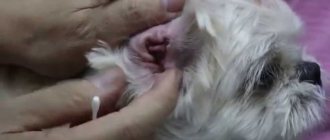Itchy ears in dogs is an extremely unpleasant thing. Owners often call it “ear mange.” The ears may itch deep inside, and no matter what the dog does, the unpleasant sensation does not go away. The dog can scratch its ears with its front and hind paws, rub its head on the carpet, furniture, and people. If you see that your pet is often and intensively trying to “help” you scratch, jerking its back paw when you pat it behind the ear, as if it were scratching itself, welcome to see a veterinarian. If the itching is severe, the dog may scratch his ears until they bleed. It is better not to let this happen and take action at the first signs of illness. It is always easier to prevent a disease than to treat it, and an examination by a doctor is never superfluous.
Diagnostics
Only a veterinarian can make a diagnosis based on anamnesis (collection of information about the pet’s lifestyle), examination and additional research. For example, otoscopy of the middle and inner ear will make it clear where the inflammatory process is localized, and microscopy of the discharge from the auricle will show what exactly could cause the inflammation.
What symptoms may bother your dog besides itching:
- pain - the dog will whine and actively rub its ear with its paws, tilting its head. Trying to look may cause anxiety, discomfort or aggression on the part of the animal;
- a “squelching” sound when pressing on the base of the ear or when the dog shakes its head;
- local redness of the skin, swelling;
- discharge from the ear that is black, gray, yellow or off-white;
- foul odor from the ears;
- enlarged submandibular lymph nodes, general depressed condition of the dog, lethargy;
Each of these symptoms indicates that something is wrong with your ears. The solution to the problem must be approached comprehensively and as quickly as possible.
Itchy ear - what could it be?
What should a healthy dog's ear look like?
Normally, the animal's ear should be light pink without spots or plaque. A small amount of earwax is acceptable, which protects the ear canal from pathogenic microbes. There should be no other discharge. Also, normally, the animal’s ears do not peel, they do not develop a rash, or foci of inflammation - such symptoms only indicate the presence of pathology. This applies to representatives of all breeds, including long-eared individuals. Exceptions can only occur if the dog has congenital characteristics of the auditory organs - darker color, altered shape.
What should a dog's ears smell like? Normally it shouldn't exist at all. Any odor, even a slight one, indicates that not everything is all right with the animal, not to mention the foul-smelling discharge that can accompany various inflammatory processes.
Otohematoma
Otohematoma is an accumulation of blood between the ear cartilage and the skin. It rarely causes itching, but it causes obvious discomfort to the four-legged friend - the dog whines and shakes its head. You will not confuse this disease with anything - the dog’s ear looks like an inflated hot balloon. The cause is damage to a blood or lymphatic vessel (capillary) due to injury. Dogs with floppy ears are predisposed to the appearance of otohematoma, but straight-eared breeds can also suffer. Often, an ear hematoma can occur due to itching, when the dog often scratches its ears, hitting the ear with its paw.
Treatment of otohematoma is usually surgical - drainage is installed at the site of the hematoma, and the skin is sutured to the cartilage.
Why does a dog scratch its ears?
If the dog begins to scratch its ears more often than usual, the owner will definitely pay attention to this, especially if the itching is accompanied by restlessness and whining. There may be several reasons for this behavior.
Allergy . As a result of a specific reaction, swelling of the ear canal and accumulation of effusion occurs. Severe itching and redness appears. Pathogenic microorganisms often develop on sensitive mucous membranes and aggravate the problem.
Parasitic otitis media . Usually caused by microscopic mites of the genus Otodectes, therefore it is called otodecosis. It occurs as inflammation of the auricle with the release of brown exudate. The dog experiences increasing itching and scratches its ears often until it bleeds. As a result, a secondary infection occurs. In severe cases, hearing loss may occur. Itching can also be caused by subcutaneous parasites that live in the skin around the ear.
Bacterial otitis media . Develops as a result of the activity of pathogenic microbes. Accompanied by purulent or serous exudate from the ear, increasing pain, itching, discomfort, increased local or general temperature. Often the animal behaves restlessly and keeps its head tilted towards the sore ear. This reduces pressure in the inner ear and dulls pain.
Fungal otitis media . The normal microflora of the ear contains opportunistic fungi. Normally, they do not cause disease, but begin to actively multiply under favorable conditions: immunodeficiency states, diseases of the ears, digestive tract, diabetes, etc. Fungal otitis media in its pure form is rare.
Foreign body . Plant seeds, small twigs, etc. can get into your ears. Itching can be caused by water in the ear flap or a build-up of dirt and wax, especially in dogs with floppy ears or hairy ear canals.
Trauma . Cuts, scratches or hematomas of the auricle are accompanied by pain and itching of the wound.
Neoplasm . Papillomatous growths occur more often against the background of chronic otitis. But other tumors are also registered.
Inflammatory otitis media
Otitis media is an acute or chronic inflammatory process in the ear canal. Otitis media can be caused by the development of bacteria, fungi, or both. It may be a skin reaction to injury, parasites, or an allergen. Most often accompanied by severe swelling, inflammation, pain, itching and discharge from the ear with an unpleasant odor. Dog breeds with floppy ears are more prone to developing otitis media.
The treatment is comprehensive, using special medications in the form of drops and solutions, antiseptics and anti-inflammatory drugs. Particular attention is paid to finding the main cause that caused such inflammation.
Why do dachshunds have red ears inside?
The main reasons why a dachshund's ears are red on the inside are:
- ear mites;
- ingress of plant particles;
- infectious process (otitis);
- allergy.
In any case, a thorough examination is carried out to identify and eliminate the causes of redness. If foreign objects are visible, they are carefully removed. If traces of ear mites are detected, the use of specific antiparasitic agents is required.
If the ear is red and contains dark, non-purulent discharge with an unpleasant odor, an allergy may be suspected. In such situations, you should reconsider your pet's diet. But it is important not to confuse the signs of allergy with otitis media; in difficult cases, it is better to consult a doctor.
In case of an allergic reaction, you need to find out the allergen and permanently exclude it from the dog’s menu. If she is on a dry diet, it is worth remembering the composition of the food and changing it to a hypoallergenic one. If allergies occur again, this will allow you to compare the qualitative composition of the components and find out which of them provokes undesirable consequences.
If the animal eats natural food, it is more difficult to identify the allergen. To do this, exclude from the diet everything that can provoke the appearance of undesirable reactions, and after eliminating the signs, discontinued foods are introduced one at a time every 3-5 days. The reappearance of similar problems indicates intolerance to the last introduced product.
Remember, dachshunds are strictly prohibited from giving:
- fat;
- spicy;
- products containing sugar;
- bakery products;
- food from the master's table.
Very often, allergies develop to chicken. Therefore, you should be especially careful with this product.
Allergic otitis media
Ears are one of the most delicate and vulnerable places. If a dog has inflammation and otitis media of the external auditory canal, then in approximately 70% of cases it will be associated with allergies. The ears become inflamed with food allergies and with atopic dermatitis (allergies to environmental allergens) and allergies to parasites. The outer ear will appear inflamed, and when the owner tries to look inside, the dog may whine, snarl, and try to hide or run away. When examined by a veterinarian through an otoscope, inflammation with discharge (inflammatory secretion) will be detected.
As a rule, treatment for allergic otitis is complex and will be prescribed by a doctor individually for each dog. The treatment regimen may greatly depend on the cause of the allergy. In addition to complex treatment aimed at eliminating the cause of the allergy and relieving symptoms, sanitation and treatment of the ear canal with antibacterial and antifungal drugs will also most likely be prescribed. In order to reduce itching during treatment and thereby make the dog’s life easier, the doctor may prescribe Apoquel. This drug will relieve attacks of itching and eliminate the factor of trauma when scratching; it also helps relieve inflammation.
Development of the disease
Serous discharge begins in the auricle. Use the corners of furniture to scratch your head. Subsequently, the serous discharge will be replaced by purulent discharge. An unpleasant putrid smell appears from the ears. A crust forms on the inside of the ear, in the pinna. The dog whines, shakes its head, unable to find peace. Her hearing is significantly deteriorating. Complications begin in the later stages:
- Otitis – inflammation of the external auditory canal; The dog has difficulty swallowing and may make circular movements towards the most affected ear.
- Labyrinthitis (inflammation of the inner ear) causes the animal to sit with the affected ear tilted downwards (bowheadedness).
At the last stage of the disease, inflammation of the lining of the brain begins. The dog may experience nervous attacks, convulsions, and shakes. This stage is almost always fatal.
Foreign body
A dog is not a child and cannot put a foreign object in its ear. But it is not uncommon for grass or tenacious plant seeds, burdock or an insect to accidentally get into the ear. The foreign body causes discomfort to the dog - the dog persistently rubs its ear with its paws and whines. It is necessary to examine the ear yourself as quickly as possible or take your pet to a veterinarian. If a foreign body remains in the ear for a long time, serious inflammation may develop, which will require long-term treatment.
What to do if your dog often scratches its ears
Now you know the possible reasons for this behavior, so all that remains is to decide on ways to help your pet. To choose the right treatment option, you need to establish an accurate diagnosis. In such cases, it is better not to rely on your own intuition, but to contact a qualified veterinarian.
Important! If a dog shakes its head and scratches its ears, it means it is experiencing discomfort and irritation, which can cause it to become aggressive and behave unpredictably. If this is a large breed dog, such irritability can lead to dire consequences, so it is important to identify the causes and begin treatment as soon as possible.
Any disease not diagnosed in time or not fully treated can lead to deafness, rupture of the eardrum, pus entering the brain and ultimately death. Only after testing and examining the pet will the veterinarian be able to prescribe effective treatment.
For ear mites
If such a diagnosis is made, acaricidal, antibacterial and anti-inflammatory drugs are prescribed. But before starting treatment, you should definitely clean the auricle. The most effective for this problem are drops (“Otovedin”, “Advocate”, “Deternol”. But they act only on adult individuals, so after a week they require repeated treatment, which helps prevent inflammation caused by grown-up parasites. In addition, it is important to disinfect toys and rugs and other things that the dog uses.
For otitis media
First of all, it is necessary to cure the primary disease if the inflammatory process is caused by an infection or parasites. In severe cases, antibacterial therapy, washing sinks and treating wounds with hydrogen peroxide are prescribed. When purulent forms develop, drops with an analgesic and anti-inflammatory effect are usually used - Otipax, Sofradex. The latter contain an antibiotic (neomycin), and therefore provide more effective treatment.
For allergies
First of all, you need to take an antihistamine, and then identify the source that provokes this reaction. Often in such cases, medications are prescribed to remove fluid from the body, special ointments for treating damaged surfaces, and a strict diet for the pet.
If a foreign body enters
In such a situation, it is strictly not recommended to remove it yourself, but it is better to contact a veterinarian for this. Before carrying out the procedure, it is advisable to immobilize the pet as much as possible, since if he jerks his head, the foreign body may move even deeper. Additionally, sedatives and local anesthesia may be needed to reduce discomfort for your pet.
Otodectosis
This is a parasitic disease caused by ticks of the genus Otodectes cynotis. The mite feeds on earwax, lymph and epidermis. The vital activity of the parasite causes unbearable itching and inflammation in dogs. Only a veterinarian can confirm the diagnosis of otodectosis after examination and laboratory diagnosis of the discharge - the mite can be easily seen through a microscope.
Dogs suffer from otodectosis much less frequently than cats. But a dog can easily pick up this parasite on the street or from a sick feline.
Treatment for otodectosis is quite simple - hygienic cleaning of the ears and a drug aimed at destroying the Otodectes cynotis mite. Simparica tablets are excellent for treatment and prevention. They do not have a toxic effect on the dog’s body, but are highly active against mites that cause otodecosis.
In addition to tablets, ear mites respond well to treatment with Stronghold drops. For complete recovery, one or two treatments with an interval of 30 days are enough. In the future, the drug can also be used for prevention.
Signs of a dog's hearing organ disease
A red ear inside a dog is the first sign of illness in the animal’s hearing organs. If the dog shakes its head, lowers it to its side, constantly scratches the parotid area, there is abundant sulfur discharge accompanied by an unpleasant odor, and the ear itself “squelches”, and, on top of everything else, the pet behaves nervously, eats and sleeps poorly, then there is fact of animal ear disease.
The signs of canine ear diseases are similar to each other, so it is not advisable to self-medicate, but it is better to seek help from a veterinarian who will make an accurate diagnosis and prescribe the necessary treatment.
Other parasites
In addition to ear mites, other parasites also attack dog ears - fleas, subcutaneous mites (demodex), scabies mites (sarcoptic mange), and ixodid (forest) mites. Bloodsuckers can be located anywhere on a dog’s body; they also love the ears, because the skin on them is tender enough to easily bite through it. The bites also cause itching. And when a dog itches, it can injure its ear. Trauma can cause both local inflammation and otohematoma. In addition to causing discomfort, fleas and ticks are carriers of dangerous diseases. Therefore, it is much easier to prevent all parasitic diseases than to treat their consequences.
The optimal solution for prevention is Simparica tablets. They protect against fleas and several types of ticks at once - ixodid (forest), ear (otodectosis), scabies (sarcoptic mange), subcutaneous (demodectic mange). In the warm season, the tablet is a dog’s salvation from many parasites and the diseases they carry.
Treatment
Treatment of the ears should be aimed at the cause of inflammation and itching. It is important to maintain hygiene and not allow your dog to itch. To prevent scratching, you can use a collar, but the best solution is Apoquel. This is an innovative drug for relieving itching during diagnosis and treatment. It solves the problem at the cellular level and is well tolerated by the four-legged friend.
For each case there is an individual treatment that must be prescribed by a veterinarian. In order for the doctor to see the clinical picture as much as possible, do not treat the dog’s ears with anything before the doctor’s appointment.
Prevention
The best way to combat a disease is its prevention. To prevent your dog from getting otitis due to parasitic diseases, treat your pet regularly for fleas and ticks. Drugs such as Simparica and Stronghold are active against these parasites and will protect your pets from uninvited guests.
Keep an eye on your pet's ears by cleaning them regularly with lotion and a cotton pad. Do not clean your ear with cotton swabs - this can cause harm. To clean your dog's ears, pour a small amount of lotion into the ear canal, massage the base of the ear and allow the dog to shake its head vigorously. Excess wax will end up on the inside of the ear, where it can be easily wiped off with a cotton pad or gauze.
If you know that your dog is prone to food allergies, carefully follow the diet and talk with all family members so that they do not feed it from the table. This is extremely important for allergic animals. For other types of allergies, when the first signs of exacerbation appear, contact your veterinarian as soon as possible to prevent scratching.
Health to you and your pets!
Causes
The risk group includes representatives of breeds that are characterized by long, drooping ears. The large auricle closes the internal canals of the hearing organ, which prevents proper ventilation.
This leads to the accumulation of moisture in the ear, which is a suitable environment for the proliferation of pathogenic microorganisms - fungi and bacteria that provoke inflammation.
The causes of the symptom include water getting into the ear canal . In excess fluid, pathogenic bacteria and fungi rapidly multiply, which leads to ear pain and redness of the inside of the ear.
A bite from a blood-sucking insect (tick, mosquito, midge) or contact with a poisonous plant is manifested by local redness with clear boundaries. This phenomenon often occurs in pets that go hunting with their owners.
Redness and pain in a dog's ears occurs as a reaction to a foreign body entering the ear canal - an insect, a thorn, etc. The animal behaves restlessly - shakes its head, scratches the affected area, does not sleep and loses its appetite.
Possible diseases
Most often, itching, redness and pain in the ears occur as a symptom of the following diseases:
- bacterial otitis;
- otodectosis;
- otomycosis (fungal otitis);
- allergic otitis.
Bacterial otitis is an inflammation of the middle and outer ear caused by a bacterial infection. Affects one or both hearing organs. Occurs when immunity decreases, fluid gets into the ear canal, and as a complication of other infectious diseases.
Your pet will experience the following symptoms:
- the auricle turns red and becomes hot to the touch;
- neck muscles tense;
- the dog tilts its head to the side;
- the animal does not allow you to touch the affected ear - it runs away and shows aggression.
When the disease is complicated, purulent discharge appears from the ear canal. Body temperature rises to 39-40 °C.
Otodectosis occurs in young dogs. A parasitic mite that infects the ears feeds on the animal's lymph. A microscopic insect on the inside of the ear gnaws passages in which it lays eggs. Here the tick goes through all stages of development, parasitizing the animal. The causative agent of otodectosis also affects other parts of the body. The disease is transmitted from infected animals to healthy ones. A dog can become infected with otodectosis from cats, birds and other pets.
The defeat is accompanied by the following symptoms:
- itching;
- black discharge from the ears;
- unpleasant odor from the ears.
Advanced otodectosis provokes necrosis of the eardrum, which leads to hearing loss . Severe damage to the ear canal increases the risk of developing meningitis.
Fungal otitis media develops due to decreased immunity after severe illness, antibiotic therapy, stress and surgery. These factors provoke the active proliferation of pathogenic fungi in the ears, which manifests itself:
- local redness;
- itching;
- yellow coating;
- moldy smell.
Allergic otitis media occurs as a reaction to food components, hygiene products, and veterinary drugs. Allergies cause:
- rapid redness of the skin on the inside of the ear;
- local swelling;
- small rash;
- severe itching.
A rapid increase in symptoms provokes restless behavior in the pet.










